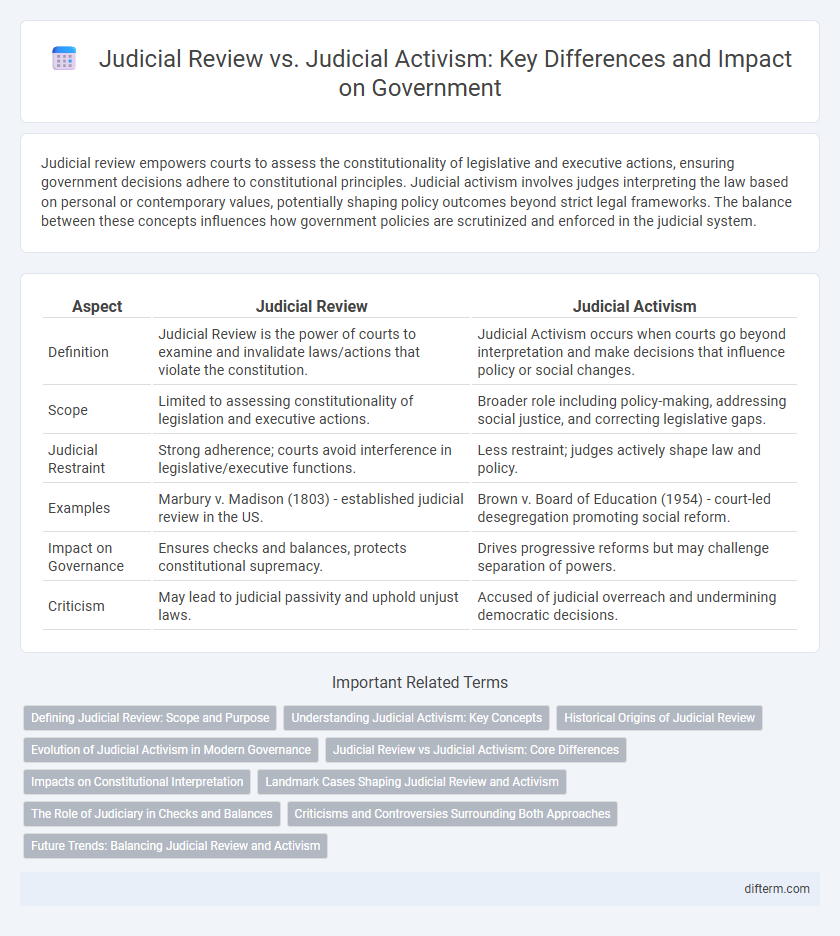Judicial review empowers courts to assess the constitutionality of legislative and executive actions, ensuring government decisions adhere to constitutional principles. Judicial activism involves judges interpreting the law based on personal or contemporary values, potentially shaping policy outcomes beyond strict legal frameworks. The balance between these concepts influences how government policies are scrutinized and enforced in the judicial system.
Table of Comparison
| Aspect | Judicial Review | Judicial Activism |
|---|---|---|
| Definition | Judicial Review is the power of courts to examine and invalidate laws/actions that violate the constitution. | Judicial Activism occurs when courts go beyond interpretation and make decisions that influence policy or social changes. |
| Scope | Limited to assessing constitutionality of legislation and executive actions. | Broader role including policy-making, addressing social justice, and correcting legislative gaps. |
| Judicial Restraint | Strong adherence; courts avoid interference in legislative/executive functions. | Less restraint; judges actively shape law and policy. |
| Examples | Marbury v. Madison (1803) - established judicial review in the US. | Brown v. Board of Education (1954) - court-led desegregation promoting social reform. |
| Impact on Governance | Ensures checks and balances, protects constitutional supremacy. | Drives progressive reforms but may challenge separation of powers. |
| Criticism | May lead to judicial passivity and uphold unjust laws. | Accused of judicial overreach and undermining democratic decisions. |
Defining Judicial Review: Scope and Purpose
Judicial review empowers courts to assess the constitutionality of legislative and executive actions, ensuring laws comply with the fundamental legal framework. Its scope includes invalidating statutes or government decisions that violate constitutional provisions, maintaining the supremacy of the constitution. The purpose of judicial review centers on preserving the balance of power among branches of government and protecting individual rights against potential governmental overreach.
Understanding Judicial Activism: Key Concepts
Judicial activism refers to the judiciary's proactive role in interpreting laws and the Constitution to address social issues and prevent injustice, often expanding beyond traditional interpretations. It contrasts with judicial restraint, where courts defer to the legislative and executive branches unless a clear constitutional violation occurs. Key concepts include the balance of power, protection of minority rights, and the evolving nature of legal precedents to reflect societal changes.
Historical Origins of Judicial Review
Judicial review originated with the landmark 1803 U.S. Supreme Court case Marbury v. Madison, establishing the judiciary's authority to invalidate laws conflicting with the Constitution. This principle firmly positioned courts as interpreters of constitutional limits on legislative and executive powers. Historical foundations of judicial review reflect its role as a critical check in the separation of powers within constitutional democracies.
Evolution of Judicial Activism in Modern Governance
Judicial activism has evolved significantly in modern governance as courts increasingly interpret laws beyond their literal meaning to address contemporary social issues and protect constitutional rights. This evolution reflects a shift from strict judicial review, where courts merely assess the legality of government actions, toward a more proactive role in shaping policy and promoting justice. The trend is evident in landmark decisions that expand civil liberties, influence public policy, and hold governmental branches accountable, highlighting the judiciary's growing influence in democratic societies.
Judicial Review vs Judicial Activism: Core Differences
Judicial review empowers courts to assess the constitutionality of legislative and executive actions, ensuring compliance with the constitution, while judicial activism involves judges interpreting the law based on personal or contemporary social values, often leading to broader policy changes. Judicial review maintains the balance of power by upholding the rule of law, whereas judicial activism emphasizes the dynamic role of the judiciary in advancing social justice. The core difference lies in judicial review's restrained constitutional scrutiny compared to judicial activism's proactive and sometimes expansive legal interpretations.
Impacts on Constitutional Interpretation
Judicial review empowers courts to invalidate laws conflicting with the Constitution, ensuring adherence to its original text and intent, thus maintaining constitutional stability. Judicial activism, by contrast, promotes flexible interpretation, allowing judges to adapt constitutional principles to contemporary societal values, which can lead to evolving legal standards. These differing approaches significantly influence constitutional interpretation by balancing rigid textual adherence against dynamic adaptation to modern contexts.
Landmark Cases Shaping Judicial Review and Activism
Landmark cases such as Marbury v. Madison established the principle of judicial review, empowering courts to invalidate unconstitutional laws and cementing the judiciary's role in maintaining checks and balances. Cases like Brown v. Board of Education exemplify judicial activism, where courts proactively interpreted the Constitution to promote social change and protect civil rights. These pivotal rulings continue to influence the scope and impact of judicial review and activism in shaping government policies and legal precedents.
The Role of Judiciary in Checks and Balances
Judicial review empowers courts to evaluate the constitutionality of legislative and executive actions, ensuring adherence to the rule of law while maintaining the separation of powers. Judicial activism involves courts proactively interpreting laws and constitutional provisions to address social injustices, often expanding judicial influence beyond traditional boundaries. Both mechanisms serve as critical tools for the judiciary in upholding checks and balances within government, preserving democratic accountability and preventing the abuse of power.
Criticisms and Controversies Surrounding Both Approaches
Judicial Review faces criticism for enabling unelected judges to overturn laws, potentially undermining democratic processes and legislative intent. Judicial Activism is controversial due to perceptions of judges imposing personal views, leading to concerns about subjectivity and lack of impartiality in rulings. Both approaches provoke debates on the balance between judicial independence and accountability within constitutional governance.
Future Trends: Balancing Judicial Review and Activism
Future trends in the judiciary emphasize a delicate balancing act between judicial review and judicial activism, ensuring courts uphold constitutional boundaries while adapting to evolving societal values. Emerging legal frameworks seek to refine criteria for judicial intervention, preventing overreach while affirming the judiciary's role in safeguarding rights. Advancements in legal technology and transparency further support informed, accountable decisions that harmonize activism with the principles of judicial restraint.
Judicial Review vs Judicial Activism Infographic

 difterm.com
difterm.com